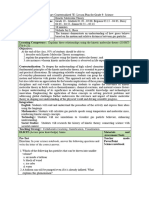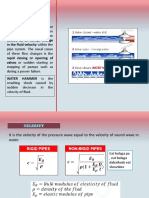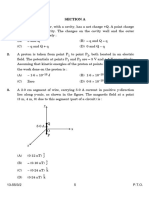SLG 12.1 Kinetic Molecular Theory
Uploaded by
Mariabella ElpusanSLG 12.1 Kinetic Molecular Theory
Uploaded by
Mariabella ElpusanINTERACTION BETWEEN PARTICLES
KINETIC MOLECULAR THEORY
At the end of this module, you should be able to:
1. Discuss the postulates of the Kinetic Molecular Theory of Matter. (C10.A.1)
2. Demonstrate how KMT explains the observed behavior of gases. (C10.A.2)
Time Allotted: 1 min Actual Time: __________
In this module, you will be introduced to another very important concept in physics and in
chemistry: The KMT or the Kinetic Molecular Theory.
Have you wondered why gas expands when heat is being added and is held at constant
pressure? Or if the gas is being squeezed at a constant temperature, how does the
pressure increase? This lesson will help you understand further about the gas properties.
According to the KMT, matter is made up of very small particles called atoms, molecules
or ions. The smallest particle of an element having the same chemical properties is
termed atom; molecule is the smallest particle of a compound and an ion is an electrically
charged atom due to gain or loss of one or more electrons. These particles are in constant
motion, and they tend to move in several ways. They vibrate, move and rotate in straight
rows as they collide with each other as shown in Figure 1 below:
Figure 1. Types of motion of particles in matter.
(Image from: Hewitt, Paul G. (2007). Conceptual Integrated Science 1st Ed. City College of San Francisco,
United States of America. Pearson Education, Inc.)
Kinetic energy is said to be the energy that a substance has because of its movement.
The energy that molecules and atoms have is very much related to their position and
motion as well. They have translational kinetic energy due to their translational
nd rotational kinetic energy. In addition, as the
(straight-line) motion as well as vibrational a
Learning Guide 12.1 | page 1 of 5
particles come closer to each other, it gains potential energy from the attractions or
repulsions between them. The sum of all forms of energy in a specific substance is termed
thermal energy (heat energy) and that is usually referred to us by physicists as internal
energy of a substance.
Time Allotted: 2 min Actual Time: __________
THE KINETIC MOLECULAR THEORY OF GASES
The KMT of Matter was developed for about 100 years, when Rudolf Clausius
(1822–1888) brought out a sufficient and complete form of his theory
The KMT explains forces between molecules and energy that they possess. This theory
can be summarized into three (3) theories of matter.
1. Small particles (atoms, ions or molecules) made up matter.
2. The volume of the molecules depends on the space between them and not the
space in which it is occupied by the molecules.
3. The molecules are said to be in constant random motion. For each of the three
states of matter (gases, liquids or solids), the motion is different. They collide with
each other and their container walls. There is no substantial drop of energy when
the molecules collide with one another, or with the container’s walls. The
temperature used to define when the motion is very slow to none, is absolute zero
(0 Kelvin or -273.15 O C).
The KMT defines both temperature and pressure at the molecular level. Molecules’
collisions with the walls of the container is due to the gas pressures as shown in Figure
1 below:
Figure 1. The molecular origin of gas pressure.
(Image from: Brown, Theodore L. & Lemay, Eugene H. (2012). Chemistry: The Central Science 12th Ed.
Pearson Prentice Hall)
The term used to explain the hotness or coldness of a substance is called temperature.
It is the total kinetic energy of the particles in the object. Molecules of the water at 0º C
will have lesser kinetic energy as compared to molecules of water at 100º C.
The gas’ absolute temperature is a measure of its molecules' average kinetic energy.
There will be the same average kinetic energy for their molecules if they have the same
temperature for the two gases. When you double the gas’ absolute temperature, the
Learning Guide 12.1 | page 2 of 5
molecules' average kinetic energy will also be doubled. Thus, greater temperature would
correspond to greater kinetic energy as well.
KINETIC MOLECULAR THEORY: APPLICATION OF GAS LAWS
As expressed by the different gas laws, the empirical findings of properties of gas are
interpreted in accordance to the principle of kinetic molecular. This argument is
demonstrated by the following examples:
1. At a constant temperature, a volume rise causes pressure to drop.
● A constant temperature ensures that gas molecules' average KE remains
unaltered. This implies that the molecular speed remains unaltered as
well. The molecules must travel a greater distance between their
collisions when the volume is increased. There are also less collisions
with respect to the container walls per unit of time, which ensures that the
pressure decreases.
2. At constant volume, a temperature increase causes pressure to rise.
● A rise in temperature ensures also a rise in the molecules' average KE
and in root-mean square speed µrms. Although there is no volume
change, the rise in temperature would cause more collisions per unit time
with respect to the walls since all the molecules are in rapid motion. In
addition, it increases the momentum of each collision (as the particles hit
the walls more and more). A higher number of strong collisions denotes
that the pressure rises and this rise is explained by the theory.
NON-GRADED FORMATIVE ASSESSMENT
Answer the following questions below by filling in the empty boxes. Some
properties of gases are given below:
Property of a Gas KMT Explanation Description Example
1. Gases have no
definite volume and
shape.
2. Gases can easily
be compressed.
3. Gases have low
densities compared to
solids and liquids.
Time Allotted: 15 min Actual Time: __________
Learning Guide 12.1 | page 3 of 5
GRADED FORMATIVE ASSESSMENT
Directions. Read each question carefully before answering. Choose only the letter
of your choice.
1. Which of the following statements below is inconsistent with the KMT of
gases?
A) The individual molecules of the gas are relatively far from each other.
B) At a constant temperature, the average KEs of different gases are the
same.
C) Most of the gases’ observed behavior at normal pressures and
temperatures is clarified by the theory.
D) At ordinary pressures and temperatures relative to the volume filled by gas,
the volume of the molecules of the gas is very small.
2. The particle’s average kinetic energy in a substance is ___________.
A) Increased as the temperature of the substance decreases.
B) Increased as the substance's temperature increases.
C) Unaffected by changes in the substance’s temperature.
D) Equivalent to the total thermal energy being absorbed by the object.
3. Rudolf Clausius proposed that heat is a form of _______ in which by changing
the movement of molecules, affects the temperature of matter.
A) energy
B) gas
C) molecular mass
D) velocity
4. When gases are at ________ or at ___________, kinetic molecular theory is
most accurate and useful.
A) high pressure; low temperature
B) low pressure; high temperature
C) high pressure; high temperature
D) low pressure; low temperature
5. Several assumptions by the kinetic molecular theory about ____________.
A) the size and weight of molecules
B) the size and motion of molecules
C) the motion and weight of molecules
D) the motion and energy of molecules
Time Allotted: 10 min Actual Time: __________
Learning Guide 12.1 | page 4 of 5
In Summary
● The KMT explains the energy and the forces between the molecules.
● Kinetic energy is said to be the energy that a substance has because of its
movement.
● The term used to explicate the coldness or hotness of a substance is called
temperature.
● At constant temperature, a volume rise causes pressure to drop.
● At constant volume, a temperature increase causes pressure to rise.
Time Allotted: 2 min Actual Time: __________
If you want to know more about Kinetic Molecular Theory of Matter, you can check the link
below for an interactive virtual simulation on Gas Properties:
https://phet.colorado.edu/en/simulation/legacy/gas-properties
Black Hills State University (2006). Earth and Physical Science for Elementary Teachers:
Middle School Science Content Knowledge Praxis Review Sheet: Kinetic Theories
and States of Matter. Retrieved from:
https://www.sdbor.edu/educators/praxis/Documents/bhsu/documents/ms_sc3.pdf
Brown, Theodore L. & Lemay, Eugene H. (2012). Chemistry: The Central Science 12th
Ed. Pearson Prentice Hall
Hewitt, Paul G. (2007). Conceptual Integrated Science 1st Ed. City College of San
Francisco, United States of America. Pearson Education.
Tarbuck, E. J. & Lutgens, F. K. (2006). Earth Science. Upper Saddle River, NJ: Pearson
Prentice Hall. ISBN Number 0-13-149751-0.
Learning Guide 12.1 | page 5 of 5
You might also like
- Science 10 LAS 4.1.1 The Kinetic Molecular TheoryNo ratings yetScience 10 LAS 4.1.1 The Kinetic Molecular Theory3 pages
- LESSON PLAN IN SCIENCE 10: Kinetic Molecular TheoryNo ratings yetLESSON PLAN IN SCIENCE 10: Kinetic Molecular Theory4 pages
- S10MT Iva B 21 KINETIC MOLECULAR THEORY ABUEVA0% (1)S10MT Iva B 21 KINETIC MOLECULAR THEORY ABUEVA5 pages
- 6.4 Kinetic Molecular Theory (Overview) - Chemistry LibreTextsNo ratings yet6.4 Kinetic Molecular Theory (Overview) - Chemistry LibreTexts1 page
- SAMBAAN Kinetic Molecular Theory of GasesNo ratings yetSAMBAAN Kinetic Molecular Theory of Gases22 pages
- Class 11 Physics Notes 2024-25 Chapter 12. Kinetic TheoryNo ratings yetClass 11 Physics Notes 2024-25 Chapter 12. Kinetic Theory50 pages
- SCIENCE 10 Q4 SLM4.kenitic MoleculartheoryNo ratings yetSCIENCE 10 Q4 SLM4.kenitic Moleculartheory12 pages
- SCIENCE-10 Q4 MOD1 Behavior-of-Gases Booklet75% (4)SCIENCE-10 Q4 MOD1 Behavior-of-Gases Booklet12 pages
- Name: Asma Hidayat Qureshi Roll No:8006 Discipline: BS-Zoology Semester:3 Cource Title:physical Chemistry Assignment TopicNo ratings yetName: Asma Hidayat Qureshi Roll No:8006 Discipline: BS-Zoology Semester:3 Cource Title:physical Chemistry Assignment Topic11 pages
- 1st Puc Physics Chapter13-Kinetic Theory Notes by U N Swamy100% (1)1st Puc Physics Chapter13-Kinetic Theory Notes by U N Swamy8 pages
- Grade 10 Unit X-XII Fourth Quarter: Matter 50 DaysNo ratings yetGrade 10 Unit X-XII Fourth Quarter: Matter 50 Days6 pages
- Hsslive Xi Physics Ayyappan CHAPTER 13 KINETIC THEORYNo ratings yetHsslive Xi Physics Ayyappan CHAPTER 13 KINETIC THEORY4 pages
- 3. Kinetic Theory of Gases & Radiation One Shot_ebf949f9-Dc85-4b58-A682-8a975ebc5ef9No ratings yet3. Kinetic Theory of Gases & Radiation One Shot_ebf949f9-Dc85-4b58-A682-8a975ebc5ef970 pages
- The Kinetic-Molecular Theory Explains The Behavior of Gases, Part INo ratings yetThe Kinetic-Molecular Theory Explains The Behavior of Gases, Part I6 pages
- Review #6 (Answers) Kinetic Molecular Theory of Matter and The Gas LawsNo ratings yetReview #6 (Answers) Kinetic Molecular Theory of Matter and The Gas Laws2 pages
- Water Hammer: Water Hammer Pressure Surge Is The Caused by An Abrupt Change in The Fluid Velocity Within TheNo ratings yetWater Hammer: Water Hammer Pressure Surge Is The Caused by An Abrupt Change in The Fluid Velocity Within The7 pages
- (Ebook) Engineering Fluid Mechanics by P. Balachandran ISBN 9788120340725, 8120340728 2024 scribd download100% (3)(Ebook) Engineering Fluid Mechanics by P. Balachandran ISBN 9788120340725, 8120340728 2024 scribd download76 pages
- 10 Science NcertSolutions Chapter 10 Intext Page 176No ratings yet10 Science NcertSolutions Chapter 10 Intext Page 1764 pages
- Chapter - 02 Properties of Fluids (1) 2No ratings yetChapter - 02 Properties of Fluids (1) 228 pages
- G7 Science Q3 - Week 1 - 2 - Force and Motion StandardsNo ratings yetG7 Science Q3 - Week 1 - 2 - Force and Motion Standards94 pages
- Astronomical Spectroscopy: Jump To Navigation Jump To SearchNo ratings yetAstronomical Spectroscopy: Jump To Navigation Jump To Search3 pages
- Download ebooks file Handbook of Vacuum Technology Second Completely Revised and Updated Edition Karl Jousten all chapters100% (12)Download ebooks file Handbook of Vacuum Technology Second Completely Revised and Updated Edition Karl Jousten all chapters65 pages
- Sistem Perpipaan: Darcy-Weisbach Diagram MoodyNo ratings yetSistem Perpipaan: Darcy-Weisbach Diagram Moody32 pages
- Handbook of Hydraulic Resistance Fourth 4Th Edition I. E. Idelchik instant download100% (2)Handbook of Hydraulic Resistance Fourth 4Th Edition I. E. Idelchik instant download48 pages
- 10 1425 Web Lec 20 MoreRotationalDynamicsNo ratings yet10 1425 Web Lec 20 MoreRotationalDynamics19 pages
- Practice Questions - Sound, Class 9, Science - EduRevNo ratings yetPractice Questions - Sound, Class 9, Science - EduRev4 pages
- Engineering Physics II ElectromagnetismNo ratings yetEngineering Physics II Electromagnetism56 pages

























































































